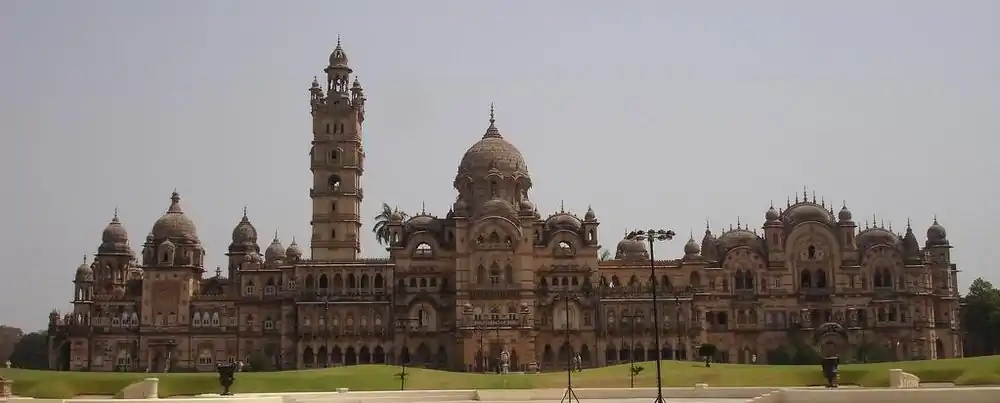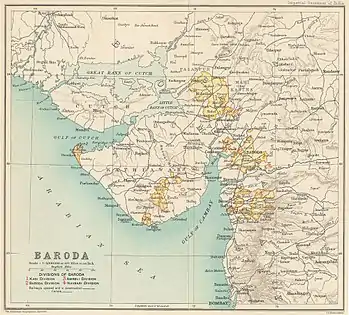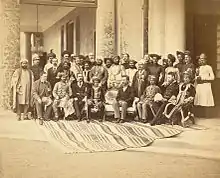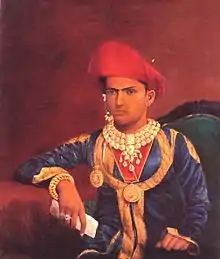Gaekwad dynasty
The Gaekwads of Baroda (also spelled as Gaikwads, Guicowars, Gaekwars) (IAST: Gāyǎkǎvāḍǎ) are Hindu Marathas who trace their origins to Dawadi village near Poona (modern Pune) to a Maratha clan by the name of Matre, which means Mantri meaning Minister.[1] Gaekwad dynasty of the Maratha Empire are originally of Kunbi origin. [2] A dynasty belonging to this clan ruled the princely state of Baroda in western India from the early 18th century until 1947.[3] The ruling prince was known as the Maharaja Gaekwad of Baroda. With the city of Baroda (Vadodara) as its capital, during the British Raj its relations with the British were managed by the Baroda Residency. It was one of the largest and wealthiest princely states existing alongside British India, with wealth coming from the lucrative cotton business as well as rice, wheat and sugar production.[4]

| Gaekwad dynasty | |||||||
|---|---|---|---|---|---|---|---|
| Former Monarchy | |||||||
| 1721–1947 | |||||||
 Flag | |||||||
 Baroda state in 1909 | |||||||
| History | |||||||
• Established | 1721 | ||||||
| 1947 | |||||||
| |||||||
Early history

The Gaekwad rule of Baroda began when the Maratha general Pilaji Rao Gaekwad conquered the city from the Mughal Empire in 1721. The Gaekwads were granted the city as a fief by Peshwa Bajirao I, the Peshwa of the Maratha empire.
In their early years, the Gaekwads served as subordinates of the Dabhade family, who were the Maratha chiefs of Gujarat and holders of the senapati (commander-in-chief) title. When Umabai Dabhade joined Tarabai's rebellion against Peshwa Balaji Baji Rao, Pilaji's son Damaji Rao Gaekwad commanded the Dabhade force. He was defeated, and remained under Peshwa's arrest from May 1751 to March 1752. In 1752, he was released after agreeing to abandon the Dabhades and accept the Peshwa's suzerainty. In return, Damaji was made the Maratha chief of Gujarat, and the Peshwa helped him expel the Mughals from Gujarat.[5]
Damaji subsequently fought alongside Sadashiv Rao, Vishwas Rao, Malhar Rao Holkar, Janakoji and Mahadji Shinde in the Third Battle of Panipat (1761). After the Maratha defeat at Panipat, the central rule of the Peshwas was weakened. As a result, the Gaekwads, along with several other powerful Maratha clans, established themselves as virtually independent rulers, while recognizing the nominal authority of the Peshwas and suzerainty of the Bhonsle Maharaja of Satara.
British suzerainty

The Gaekwads, together with several Maratha chieftains, fought the British in the First Anglo-Maratha War.
On 15 March 1802, the British intervened to defend a Gaekwad Maharaja, Anand Rao Gaekwad, who had recently inherited the throne against rival claimants, and the Gaekwads concluded the Treaty of Cambey with the British that recognized their independence from the Maratha empire and guaranteed the Maharajas of Baroda local autonomy in return for recognizing British suzerainty.
Maharaja Sayaji Rao III, who took the throne in 1875, did much to modernize Baroda, establishing compulsory primary education, a library system and the Maharaja Sayajirao University of Baroda. He also encouraged the setting up of textile factories, which helped create Baroda's textile industry. He is well known for offering B. R. Ambedkar a scholarship to study at Columbia University.
Upon India attaining its independence in 1947, the last ruling Maharaja of Baroda, Pratapsinhrao, acceded to India. Baroda was eventually merged with Bombay State, which was later divided, based on linguistic principle, into the states of Gujarat and Maharashtra in 1960.
Gaekwad, or Gayakwad, also survives as a fairly common Maratha surname, found mainly in the Indian state of Maharashtra.
Gaikwad Maharajas of Baroda

- Nandaji Rao Gaikwad, died May 1721
- Kerojirao
- Jhingojirao
- Pilaji Rao Gaikwad, reigned from 1721, died 14 May 1732
 I. Damajirao, Maharaja of Baroda, reigned from 1732, died 18 August 1768
I. Damajirao, Maharaja of Baroda, reigned from 1732, died 18 August 1768
 II. Sayajirao I, Maharaja of Baroda, reigned 1768–1778, died 1792
II. Sayajirao I, Maharaja of Baroda, reigned 1768–1778, died 1792 III. Fatehsinhrao I, Maharaja of Baroda, born before April 1751, reigned from 1778, died 26 December 1789
III. Fatehsinhrao I, Maharaja of Baroda, born before April 1751, reigned from 1778, died 26 December 1789 IV. Manajirao, Maharaja of Baroda, born before April 1751, reigned from 1789, died 27 July 1793
IV. Manajirao, Maharaja of Baroda, born before April 1751, reigned from 1789, died 27 July 1793-
 V. Govindrao, Maharaja of Baroda, born 175?, reigned from 1793, died 19 September 1800
V. Govindrao, Maharaja of Baroda, born 175?, reigned from 1793, died 19 September 1800
 VI. Anandrao, Maharaja of Baroda, born 179?, reigned from 1800, died 2 October 1819
VI. Anandrao, Maharaja of Baroda, born 179?, reigned from 1800, died 2 October 1819-
 VI. Sayajirao II, Maharaja of Baroda, born 3 May 1800, reigned from 1819, died 28 December 1847
VI. Sayajirao II, Maharaja of Baroda, born 3 May 1800, reigned from 1819, died 28 December 1847
 VII. Ganpatrao, Maharaja of Baroda, born 1816, reigned from 1847, died 1856
VII. Ganpatrao, Maharaja of Baroda, born 1816, reigned from 1847, died 1856 VIII. Khanderao II Gaekwad, Maharaja of Baroda GCSI, born 1828, reigned from 1856, died 14 June 1870
VIII. Khanderao II Gaekwad, Maharaja of Baroda GCSI, born 1828, reigned from 1856, died 14 June 1870-
 IX. Malhar Rao Gaekwad, Maharaja of Baroda, born 1831, reigned 1870 – 19 April 1875, died in obscurity in 1882
IX. Malhar Rao Gaekwad, Maharaja of Baroda, born 1831, reigned 1870 – 19 April 1875, died in obscurity in 1882
- Prataprao (d. 1737 Kavlana branch)
- Kalojirao
- Gabajirao
- Bhikajirao
- Kashirao (1832-1877)
-
 X. Sayajirao Gaekwad III, Maharaja of Baroda GCSI, GCIE, born 10 March 1863, reigned from 1875, died 6 February 1939
X. Sayajirao Gaekwad III, Maharaja of Baroda GCSI, GCIE, born 10 March 1863, reigned from 1875, died 6 February 1939
- Yuvraja Fatehsinhrao (1883-1908)
-
 XI. Pratap Singh Rao Gaekwad, Maharaja of Baroda GCIE, born 29 June 1908, reigned from 1939, titular Maharaja from 1949, deposed 1951, died 19 July 1968
XI. Pratap Singh Rao Gaekwad, Maharaja of Baroda GCIE, born 29 June 1908, reigned from 1939, titular Maharaja from 1949, deposed 1951, died 19 July 1968
 XII. Fatehsinhrao II, Maharaja of Baroda, born 2 April 1930, titular Maharaja 1951–1971, family head: 1971–1988, died 1 September 1988
XII. Fatehsinhrao II, Maharaja of Baroda, born 2 April 1930, titular Maharaja 1951–1971, family head: 1971–1988, died 1 September 1988- XIII. Ranjitsinh Pratapsinh Gaekwad, Maharaja of Baroda, born 8 May 1938, family head from 1988, died 9 May 2012
- XIV. Samarjitsinh Gaekwad, Maharaja of Baroda, born 25 April 1967, family head since 2012
-
- Yuvraja Fatehsinhrao (1883-1908)
-
- Kashirao (1832-1877)
- Bhikajirao
- Gabajirao
- Kalojirao
- Pilaji Rao Gaikwad, reigned from 1721, died 14 May 1732
- Jhingojirao
- Kerojirao
References
- Gandhinagar: Building National Identity in Postcolonial India
- Ramusack, Barbara N. (2004). The Indian Princes and their States. The New Cambridge History of India. Cambridge University Press. p. 35&36. ISBN 9781139449083.
- Streefkerk, Hein (1985). Industrial Transition in Rural India: Artisans, Traders, and Tribals in South Gujarat. Popular Prakashan. p. 111. ISBN 9780861320677.
- "India Has Rich State in Baroda". Hartford Courant. 16 August 1927.
- Charles Augustus Kincaid and Dattatray Balwant Parasnis (1918). A History of the Maratha People Volume 3. Oxford University Press. pp. 2–10.CS1 maint: uses authors parameter (link)
External links
| Wikimedia Commons has media related to Gaekwad. |
